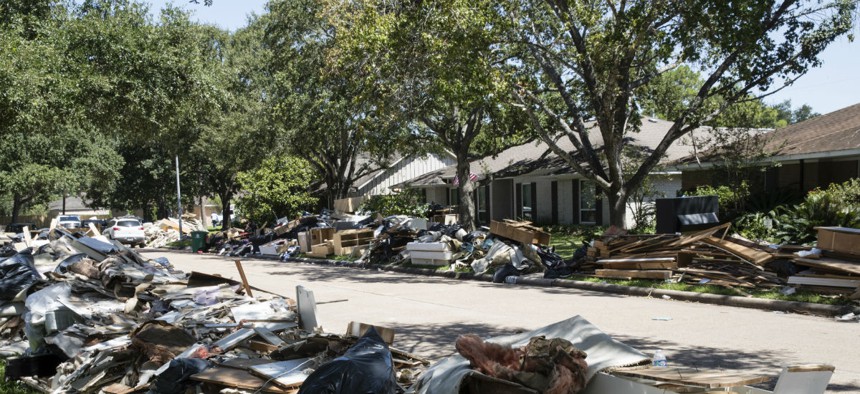GSA Relaxes Rules to Speed Contracting for Hurricane Relief Efforts
Agency raises purchase thresholds and says preference should be given to local firms.
Eight days after addressing Hurricane Harvey in Texas, the General Services Administration on Thursday pivoted to the Irma storm aimed at Florida, relaxing certain contracting rules to encourage speed and local awards.
Senior Procurement Executive Jeffrey Koses signed a “memorandum raising thresholds for areas included in the Irma declaration response,” a GSA spokeswoman told Government Executive. The Irma memorandum follows an Aug. 29 directive issued in anticipation of rebuilding in the aftermath of the Houston-area flooding from Harvey.
The Harvey memo cited sections of the Federal Acquisition Regulation allowing GSA to raise the micropurchase threshold to $20,000 for any contract to be awarded and performed, or purchase to be made in support of the designated disaster areas. “The simplified acquisition threshold is increased to $750,000, or $13,000,000 for commercial items,” the memo to GSA contracting professionals said. The authority extends to any necessary leasing of property.
The memos also give federal acquisition officers more leeway in using charge cards.They leave unchanged contract thresholds under the 1931 Davis-Bacon Act and the 1965 Service Contract Act (which require deference to local prevailing wage standards in public contracting).
Contractors seeking to help with recovery from storm damage should give preference to local firms in the disaster area “through local area set-asides,” the late August memo said. “Contracting officers should also first consider small business local area set-asides when feasible.”
Koses encouraged priority use of pre-positioned or pre-existing contracts first, such as blanket purchase agreements, schedule contracts, or indefinite delivery, indefinite quantity contracts. Government contracting officers should also “limit competition when needed,” the directive said, and paperwork can be accelerated. For example, “You do not need to submit a synopsis if the delay would seriously injure our efforts. You do need to go to the maximum competition practicable. Often, you can do that by phoning a reasonable number of sources and asking for quotes and delivery time, on the spot,” the memo said. “Justifications and approvals may take place after award, if they would unreasonably delay the acquisition. If you employ this flexibility, make sure you have a tracking system.”
GSA added a new National Interest Action code in the Federal Procurement Data System as a way to track acquisition costs of the multiple agencies involved the storms.
Rushing of disaster response aid to local governments for contracting can result in violations of federal laws designed to ensure competition and include disadvantaged vendors, a situation the Federal Emergency Management Agency faced in 2016, when it had to claw back disaster aid from the town of Louisville, Miss., which had been hit by tornadoes.
GSA’s usual role in disasters is helping other agencies in their specialties to minimize duplication of effort. The Federal Acquisition Workforce follows the National Response Framework that seeks “a coordinated, unified response among federal, tribal, state, local agencies as well as non-governmental and volunteer entities who play key roles in preparing for and relief from disasters and emergencies,” GSA’s website explains. That framework, for example, assigns emergency management to FEMA, communication to the Homeland Security department, public works to the U.S. Army Corps of Engineers, and mass care to the Health and Human Services Department.
During the 2012 Hurricane Sandy response on the East Coast, GSA used some 4,000 teleworking employees whose Washington offices were closed to rush equipment and supplies to victims and first-responders. “GSA also has deployed information technology and telecommunications systems monitoring thousands of federal facilities in the path of the storm to assess damage and ultimately return all locations to full operation,” then-Administrator Dan Tangherlini said.
This time, as the designated disaster areas evolve, GSA could also mobilize to help manage the Contingency Contracting Corps, a governmentwide set of volunteer acquisition officers set up in 2009 after the 2005 Hurricane Katrina. The corps can be activated by the White House Office of Federal Procurement Policy.
NEXT STORY: The Beginning of the End of the Debt Ceiling




